Gold(III)-Catalyzed Propargylic Substitution Reaction Followed by Cycloisomerization for Synthesis of Poly-Substituted Furans from N-Tosylpropargyl Amines with 1,3-Dicarbonyl Compounds
Abstract
1. Introduction
2. Results
3. Materials and Methods
3.1. General Information
3.2. General Procedure for Gold(III)-Catalyzed Propargylic Substitution Reaction Followed by Cycloisomerization for Synthesis of Poly-Substituted Furans 3 from N-Tosylpropargyl Amines 1 with 1,3-Dicarbonyl Compounds 2
4. Conclusions
Supplementary Materials
Author Contributions
Funding
Institutional Review Board Statement
Informed Consent Statement
Data Availability Statement
Conflicts of Interest
References
- Gutiérrez, M.; Capson, T.L.; Guzman, H.M.; González, J.; Ortega-Barría, E.; Quiñoá, E.; Riguera, R. Leptolide, a New Furanocembranolide Diterpene from Leptogorgia alba. J. Nat. Prod. 2005, 68, 614–616. [Google Scholar] [CrossRef] [PubMed]
- Riley, A.P.; Groer, C.E.; Young, D.; Ewald, A.W.; Kivell, B.M.; Prisinzano, T.E. Synthesis and κ-Opioid Receptor Activity of Furan-Substituted Salvinorin A Analogues. J. Med. Chem. 2014, 57, 10464–10475. [Google Scholar] [CrossRef]
- Phillips, M.B.; Sullivan, M.M.; Villalta, P.W.; Peterson, L.A. Covalent Modification of Cytochrome c by Reactive Metabolites of Furan. Chem. Res. Toxicol. 2014, 27, 129–135. [Google Scholar] [CrossRef] [PubMed]
- Lipshutz, B.H. Five-Membered Heteroaromatic Rings as Intermediates in Organic Synthesis. Chem. Rev. 1986, 86, 795–819. [Google Scholar] [CrossRef]
- Makarov, A.S.; Uchuskin, M.G.; Trushkov, I.V. Furan Oxidation Reactions in the Total Synthesis of Natural Products. Synthesis 2018, 50, 3059–3086. [Google Scholar]
- Brown, R.C.D. Developments of Furan Syntheses. Angew. Chem. Int. Ed. 2005, 44, 850–852. [Google Scholar] [CrossRef] [PubMed]
- Duc, D.X. Recent Progress in the Synthesis of Furan. Mini-Rev. Org. Chem. 2019, 16, 422–452. [Google Scholar] [CrossRef]
- Gluevich, A.V.; Dudnik, A.S.; Chernyak, N.; Gevorgyan, V. Transition Metal-Mediated Synthesis of Monocyclic Aromatic Heterocycles. Chem. Rev. 2013, 113, 3084–3213. [Google Scholar] [CrossRef]
- Suhre, M.H.; Reif, M.; Kirsch, S.F. Gold(I)-Catalyzed Synthesis of Highly Substituted Furans. Org. Lett. 2005, 7, 3925–3927. [Google Scholar] [CrossRef]
- Hoffmann, M.; Miaskiewicz, S.; Weibel, J.-M.; Pale, P.; Blanc, A. Gold(I)-Catalyzed Formation of Furans from γ-Acyloxyalkynyl Ketones. Beilstein J. Org. Chem. 2013, 9, 1774–1780. [Google Scholar] [CrossRef]
- Lee, H.J.; Seong, M.R.; Kim, J.N. Friedel–Crafts Reaction of the Baylis–Hillman Adducts of N-Tosylimine Derivatives. Tetrahedron Lett. 1998, 39, 6223–6226. [Google Scholar] [CrossRef]
- Seong, M.R.; Lee, H.J.; Kim, J.N. Decarbonylative Diarylation Reaction of N-Tosylated α-Amino Acids. Tetrahedron Lett. 1998, 39, 6219–6222. [Google Scholar] [CrossRef]
- Lee, H.J.; Seong, M.R.; Song, H.N.; Kim, J.N. Friedel–Crafts Reaction of Tosylamide Derivatives: A Useful Source of Carbocationic Species. Bull. Korean Chem. Soc. 1999, 20, 267–268. [Google Scholar]
- Esquivias, J.; Arrayás, R.G.; Carretero, J.C. A Copper(II)-Catalyzed Aza-Friedel–Crafts Reaction of N-(2-Pyridyl)sulfonyl Aldimines: Synthesis of Unsymmetrical Diaryl Amines and Triaryl Methanes. Angew. Chem. Int. Ed. 2006, 45, 629–633. [Google Scholar] [CrossRef] [PubMed]
- Lee, K.Y.; Lee, H.S.; Kim, H.S.; Kim, J.N. AuCl3-Catalyzed Propargylation of Arenes with N-Tosylpropargyl Amine: Synthesis of 1,3-Diarylpropanes. Bull. Korean Chem. Soc. 2008, 29, 1441–1442. [Google Scholar]
- Liu, C.-R.; Li, M.-B.; Yang, C.-F.; Tian, S.-K. Catalytic Selective Bis-arylation of Imines with Anisole, Phenol, Thioanisole and Analogues. Chem. Commun. 2008, 1249–1251. [Google Scholar] [CrossRef] [PubMed]
- He, Q.-L.; Sun, F.-L.; Zheng, X.-J.; You, S.-L. Brønsted Acid Catalyzed Synthesis of Unsymmetrical Arylbis(3-indolyl)methanes. Synlett 2009, 1111–1114. [Google Scholar]
- Liu, C.-R.; Li, M.-B.; Cheng, D.-J.; Yang, C.-F.; Tian, S.-K. Catalyst-Free Alkylation of Sulfinic Acids with Sulfonamides via sp3 C–N Bond Cleavage at Room Temperature. Org. Lett. 2009, 11, 2543–2545. [Google Scholar] [CrossRef]
- Liu, C.-R.; Yang, F.-L.; Jin, Y.-Z.; Ma, X.-T.; Cheng, D.-J.; Li, N.; Tian, S.-K. Catalytic Regioselective Synthesis of Structurally Diverse Indene Derivatives from N-Benzylic Sulfonamides and Disubstituted Alkynes. Org. Lett. 2010, 12, 3832–3835. [Google Scholar] [CrossRef]
- Yang, C.-F.; Wang, J.-Y.; Tian, S.-K. Catalytic Decarboxylative Alkylation of β-Keto Acids with Sulfonamides via the Cleavage of Carbon–Nitrogen and Carbon–Carbon Bonds. Chem. Commun. 2011, 47, 8343–8345. [Google Scholar] [CrossRef]
- Liu, J.; Wang, L.; Zheng, X.; Wang, A.; Zhu, M.; Yu, J.; Shen, Q. Yb(OTf)3-Promoted Effective Benzylation and Allylation with N-Tosylamino Group as a Stable Leaving Group. Tetrahedron Lett. 2012, 53, 1843–1846. [Google Scholar] [CrossRef]
- Liu, C.-R.; Li, M.-B.; Yang, C.-F.; Tian, S.-K. Selective Benzylic and Allylic Alkylation of Protic Nucleophiles with Sulfonamides through Double Lewis Acid Catalyzed Cleavage of sp3 Carbon–Nitrogen Bonds. Chem. Eur. J. 2009, 15, 793–797. [Google Scholar] [CrossRef] [PubMed]
- Nichols, D.E.; Nichols, C.D. Serotonin Receptors. Chem. Rev. 2008, 108, 1614–1641. [Google Scholar] [CrossRef]
- Morita, N.; Tsunokake, T.; Narikiyo, Y.; Harada, M.; Tachibana, T.; Saito, Y.; Ban, S.; Hashimoto, Y.; Okamoto, I.; Tamura, O. Gold(I)/(III)-Catalyzed Synthesis of 2-Substituted Puperidines; Vallency-Controlled Cyclization Modes. Tetrahedron Lett. 2015, 56, 6269–6272. [Google Scholar] [CrossRef]
- Morita, N.; Saito, Y.; Muraji, A.; Ban, S.; Hashimoto, Y.; Okamoto, I.; Tamura, O. Gold-Catalyzed Synthesis of 2-Substituted Azepanes; Strategic Use of Soft Gold(I) and Hard Gold(III) Catalysts. Synlett 2016, 27, 1936–1940. [Google Scholar] [CrossRef]
- Morita, N.; Miyamoto, M.; Yoda, A.; Yamamoto, M.; Ban, S.; Hashimoto, Y.; Tamura, O. Gold-Catalyzed Dehydrative Friedel-Crafts Reaction and Nazarov Cyclization Sequence: An Efficient Synthesis of 1,3-Diarylindenes from Propargylic Alcohols. Tetrahedron Lett. 2015, 57, 4460–4463. [Google Scholar] [CrossRef]
- Morita, N.; Oguro, K.; Takahashi, S.; Kawahara, M.; Ban, S.; Hashimoto, Y.; Tamura, O. Gold(III)-Catalyzed Synthesis of 2,3,4-Trisubstituted Dihydropyrans from Propargylic Alcohols with 1,3-Dicarbonyl compounds. Heterocycles 2017, 95, 172–180. [Google Scholar]
- Morita, N.; Sano, A.; Sone, A.; Aonuma, S.; Matsunaga, A.; Hashimoto, Y.; Tamura, O. Efficient One-Pot Synthesis of Substituted Oxazoles from 3-Trimethylsilylpropargylic Alcohols and Amides by Gold-Catalyzed Substitution followed by Cycloisomerization. Heterocycles 2018, 97, 719–728. [Google Scholar]
- Morita, N.; Yasuda, A.; Shibata, M.; Ban, S.; Hashimoto, Y.; Okamoto, I.; Tamura, O. Gold(I)/(III)-Catalyzed Synthesis of Cyclic Ethers; Vallency-Controlled Cyclization Modes. Org. Lett. 2015, 17, 2668–2671. [Google Scholar] [CrossRef]
- Biasiolo, L.; Trinchillo, M.; Belanzoni, P.; Belpassi, L.; Brusico, V.; Ciancaleoni, G.; D’Amora, A.; Macchioni, A.; Tarantelli, F.; Zuccaccia, D. Unexpected Anion Effect in the Alkoxylation of Alkynes Catalyzed by N-Heterocyclic Carbene (NHC) Cationic Gold Complexes. Chem. Eur. J. 2014, 20, 14594–14598. [Google Scholar] [CrossRef]
- Jia, M.; Bandini, M. Counterion Effects in Homogeneous Gold Catalysis. ACS Catal. 2015, 5, 1638–1652. [Google Scholar] [CrossRef]
- Sabatelli, F.; Segato, J.; Belpassi, L.; Del Zotto, A.; Zuccaccia, D.; Belanzoni, P. Monitoring of the Pre-Equilibrium Step in the Alkyne Hydration Reaction Catalyzed by Au(III) Complexes: A Computational Study Based on Experimental Evidences. Molecules 2021, 26, 2445. [Google Scholar] [CrossRef] [PubMed]
- Wierschke, S.G.; Chandrasekhar, J.; Jorgensen, W.L. Magnitude and Origin of the β-Silicon Effect on Carbenium Ions. J. Am. Chem. Soc. 1985, 107, 1496–1500. [Google Scholar] [CrossRef]
- Kozar, L.G.; Clark, R.D.; Heathcock, C.H. Synthesis of Bicyclo[2.2.2]octenes and Bicyclo[3.2.2]nonenes by π-Cyclization. J. Org. Chem. 1977, 42, 1386–1389. [Google Scholar] [CrossRef]
- Dénès, F.; Pérez-Luna, A.; Chemla, F. Addition of Metal Enolate Derivatives to Unactivated Carbon–Carbon Multiple Bonds. Chem. Rev. 2010, 110, 2366–2447. [Google Scholar] [CrossRef]
- Rodríguez, A.; Moran, W.J. Furan Synthesis through AuCl3-Catalysed Cycloisomerization of β-Alkynyl β-Ketoesters. Tetrahedron Lett. 2011, 52, 2605–2607. [Google Scholar] [CrossRef]
- Murakami, M.; Inouye, M.; Suginome, M.; Ito, Y. Reactions of (Triphenylphosphine)gold(I) Enolates and Homoenolates. Bull. Chem. Soc. Jpn. 1988, 61, 3649–3652. [Google Scholar] [CrossRef]
- Yao, X.; Li, C.-J. Highly Efficient Addition of Activated Methylene Compounds to Alkenes Catalyzed by Gold and Silver. J. Am. Chem. Soc. 2004, 126, 6884–6885. [Google Scholar] [CrossRef]
- Nguyen, R.-V.; Yao, X.-Q.; Bohle, D.S.; Li, C.-J. Gold- and Silver-Catalyzed Highly Regioselective Addition of Active Methylenes to Dienes, Triene, and Cyclic Enol Ethers. Org. Lett. 2005, 7, 673–675. [Google Scholar] [CrossRef]
- Zhou, C.-Y.; Che, C.-M. Highly Efficient Au(I)-Catalyzed Intramolecular Addition of β-Ketoamide to Unactivated Akenes. J. Am. Chem. Soc. 2007, 129, 5828–5829. [Google Scholar]
- Wang, Y.-F.; Wang, C.-J.; Feng, Q.-Z.; Zhai, J.-J.; Qi, S.-S.; Zhong, A.-G.; Chu, M.-M.; Xu, D.-Q. Copper-Catalyzed Asymmetric 1,6-Conjugate Addition of in situ Generated para-Quinone Methids with β-Ketoesters. Chem. Commun. 2022, 58, 6653–6656. [Google Scholar] [CrossRef] [PubMed]
- Komiya, S.; Kochi, J.K. Reversible Linkage Isomerisms of β-Diketonato Ligands. Oxygen-Bonded and Carbon-Bonded Structures in Gold(III) Acetylacetonate Complexs Induced by Phosphines. J. Am. Chem. Soc. 1977, 99, 3695–3704. [Google Scholar] [CrossRef]
- Zharkova, G.I.; Baidina, I.A.; Igumenov, I.K. X-Ray Diffraction Study of Volatile Complexes of Dimethylgold(III) Derived from Symmetrical β-Diketones. J. Struc. Chem. 2006, 47, 1117–1126. [Google Scholar] [CrossRef]
- Li, L.; Zhao, M.-N.; Ren, Z.-H.; Li, J.; Guan, Z.-H. Synthesis of Tetrasubstituted NH Pyrroles and Polysubstituted Furans via an Addition and Cyclization Strategy. Synthesis 2012, 44, 532–540. [Google Scholar] [CrossRef]
- Masuyama, Y.; Hayashi, M.; Suzuki, N. SnCl2-Catalyzed Propargylic Substitution of Propargylic Alcohols with Carbon and Nitrogen Nucleophiles. Eur. J. Org. Chem. 2013, 2013, 2914–2921. [Google Scholar] [CrossRef]

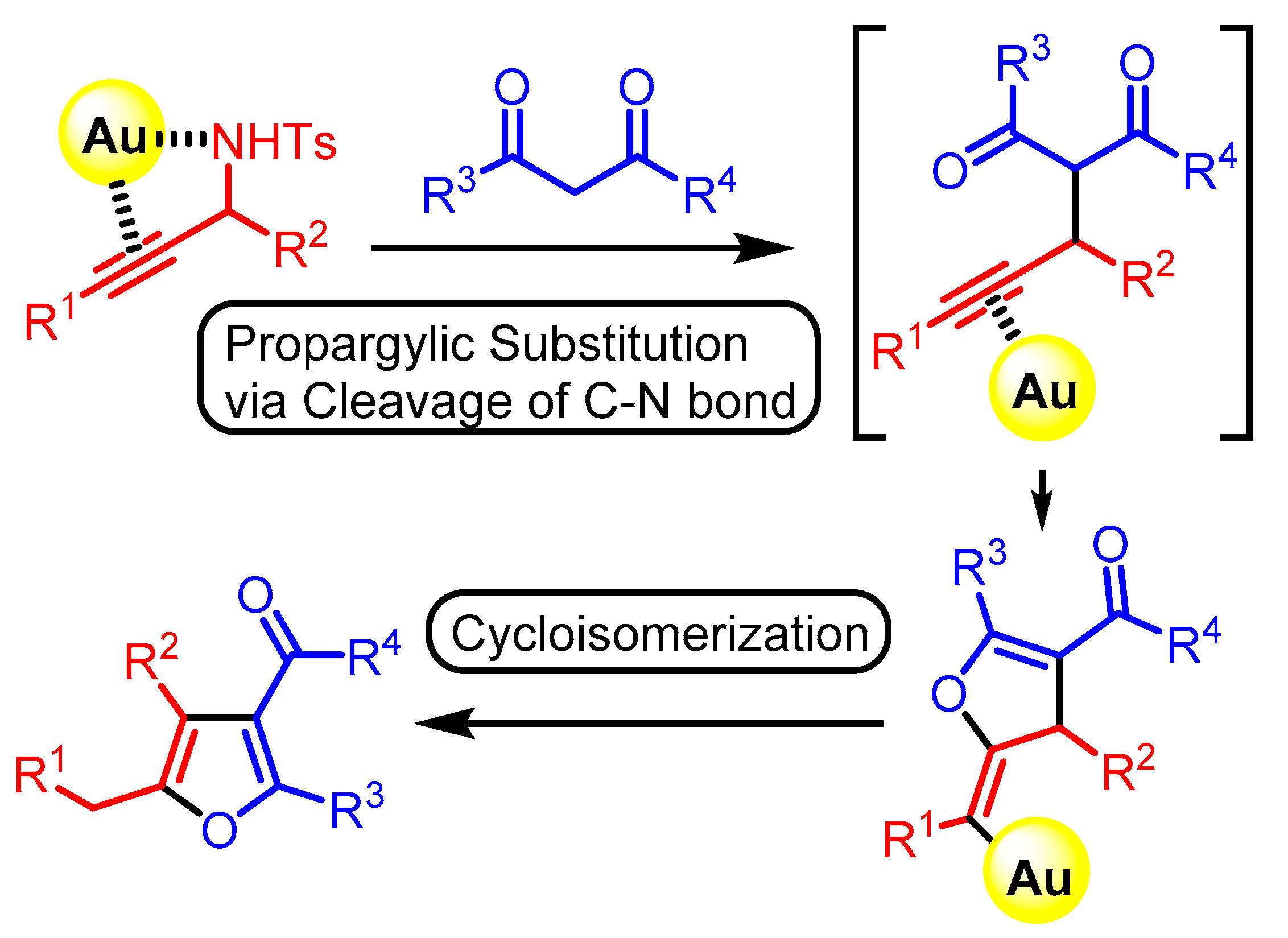

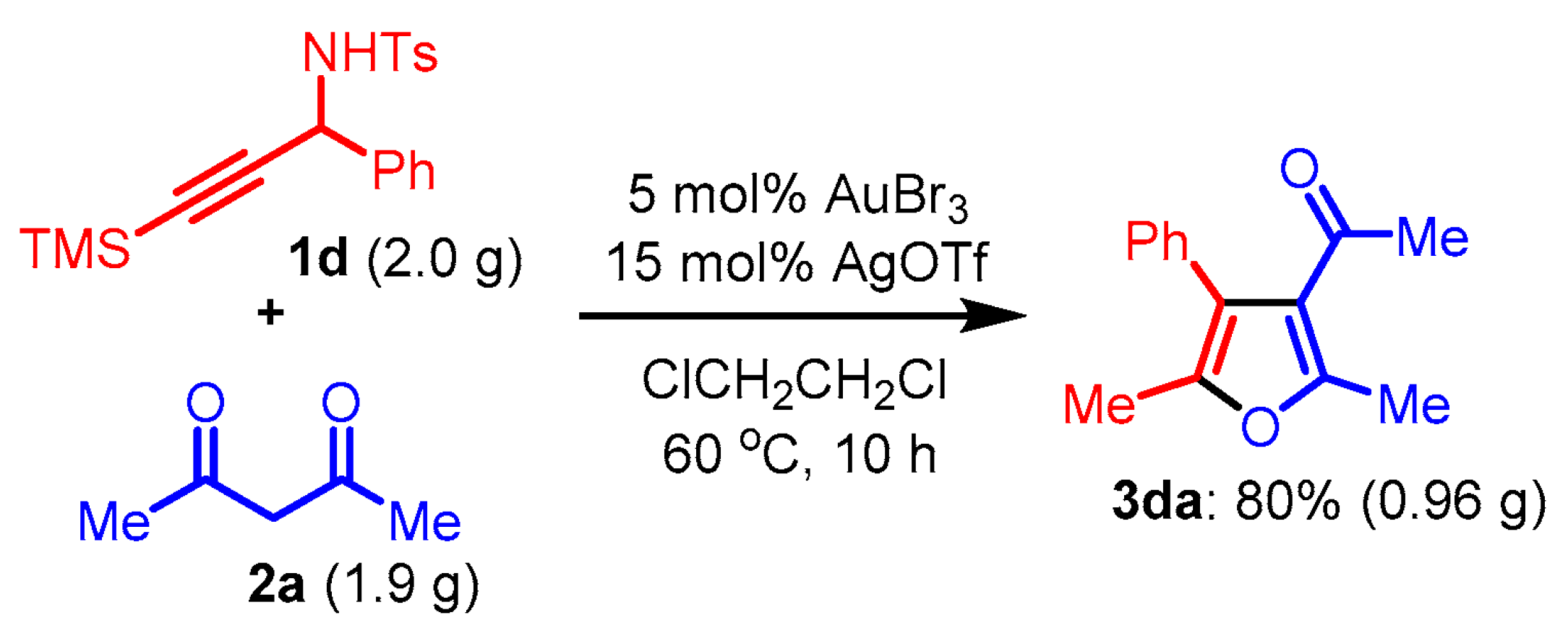

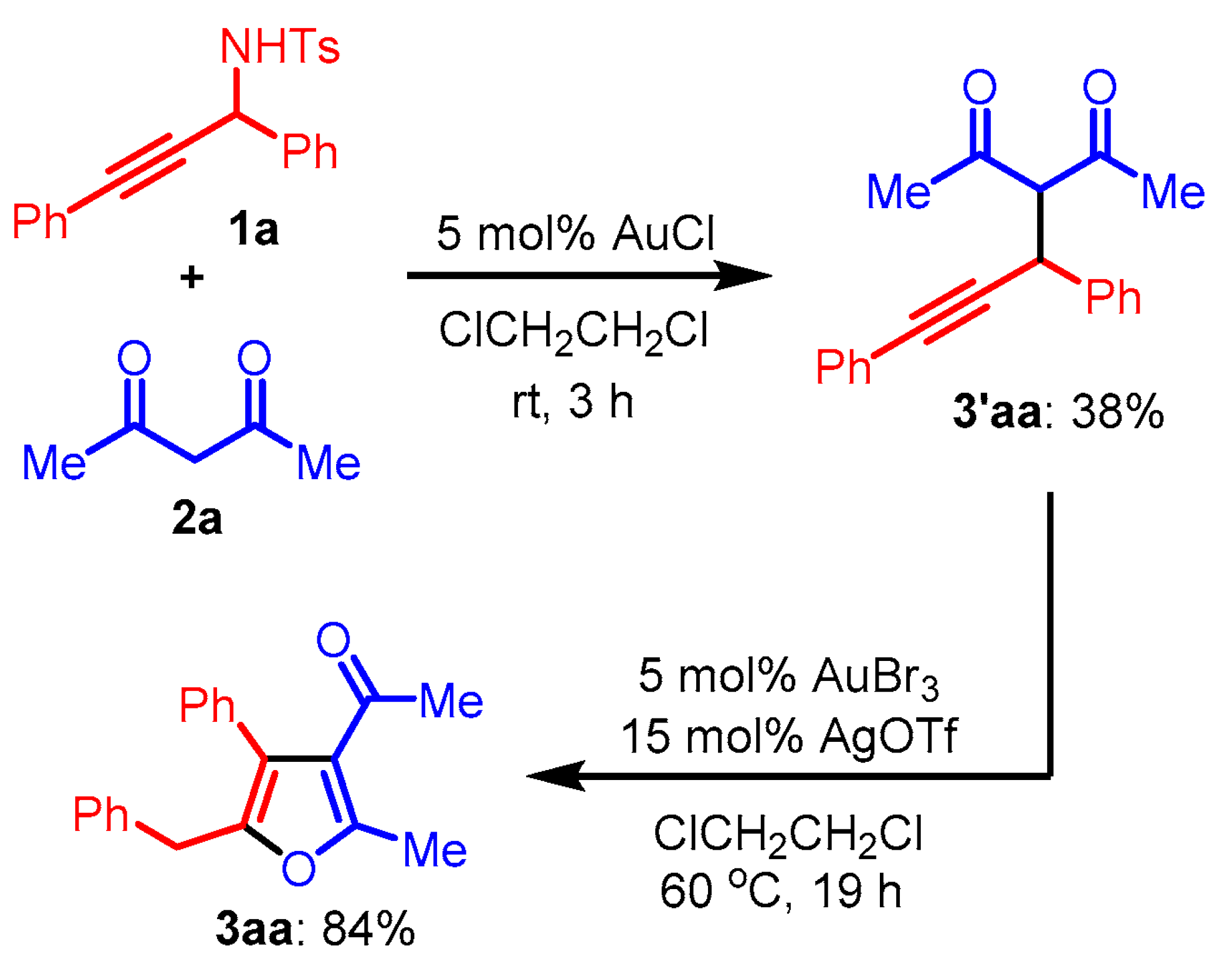
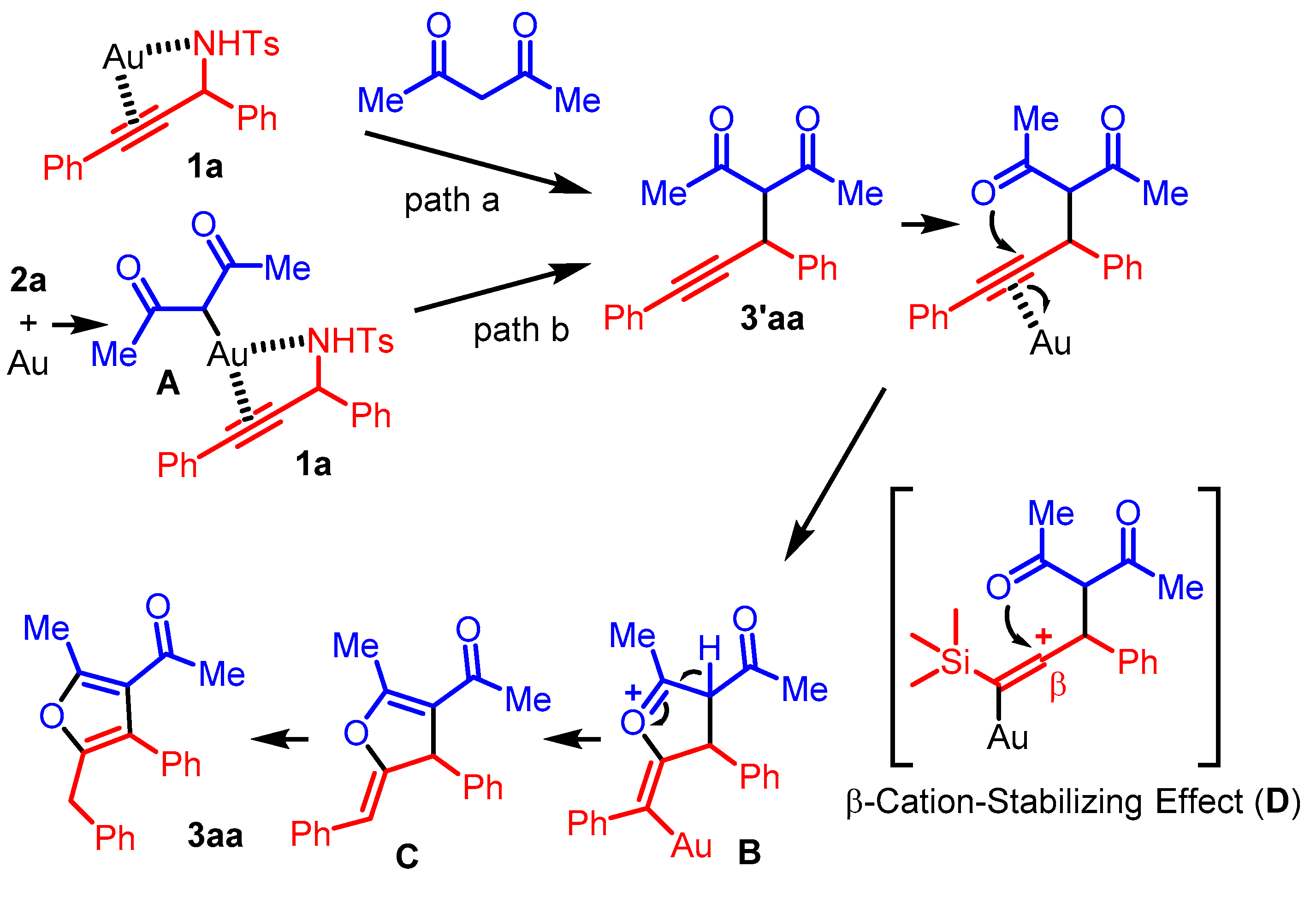

| Entry | Cat. Au (mol%) | x Eq. | Temp. | Time | 3aa Yield |
|---|---|---|---|---|---|
| 1 | AuBr3 (5) | 1 | reflux | 4 h | 23% |
| 2 | AuBr3 (5) | 3 | reflux | 7 h | 33% |
| 3 | AuBr3 (5) | 10 | reflux | 7 h | complex mixture |
| 4 | AuBr3 (5)/AgOTf (15) | 1 | 60 °C | 5 h | 63% |
| 5 | AuBr3 (5)/AgOTf (15) | 3 | 60 °C | 10 h | 71% |
| 6 | AuBr3 (5)/AgOTf (15) | 3 | 60 °C | 19 h | 81% |
| 7 | AuCl (5) | 3 | 60 °C | 19 h | 7% |
| 8 | AuCl (5)/AgOTf (15) | 3 | 60 °C | 19 h | 26% |
| 9 | Ph3PAuCl (5) | 3 | 60 °C | 19 h | trace |
| 10 | Ph3PAuCl (5)/AgOTf (5) | 3 | 60 °C | 19 h | 25% |
| 11 | NHCAuCl (5) | 3 | 60 °C | 19 h | trace |
| 12 | NHCAuCl (5)/AgOTf (5) | 3 | 60 °C | 19 h | 22% |

| Entry | Silver Catalyst | Yield |
|---|---|---|
| 1 | AgOTf | 81% |
| 2 | AgNTf2 | 46% |
| 3 | AgSbF6 | 43% |
| 4 | AgBF4 | 24% |
| 5 | AgPF6 | no reaction |

| Entry | Solvent | Yield |
|---|---|---|
| 1 | ClCH2CH2Cl | 81% |
| 2 | MeNO2 | 43% |
| 3 | Toluene | 33% |
| 4 | CF3CH2OH | 24% |
| 5 | CH3CN | complex mixture |
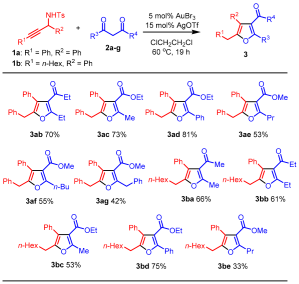
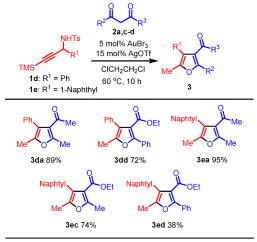
Disclaimer/Publisher’s Note: The statements, opinions and data contained in all publications are solely those of the individual author(s) and contributor(s) and not of MDPI and/or the editor(s). MDPI and/or the editor(s) disclaim responsibility for any injury to people or property resulting from any ideas, methods, instructions or products referred to in the content. |
© 2024 by the authors. Licensee MDPI, Basel, Switzerland. This article is an open access article distributed under the terms and conditions of the Creative Commons Attribution (CC BY) license (https://creativecommons.org/licenses/by/4.0/).
Share and Cite
Morita, N.; Uchida, S.; Chiaki, H.; Ishii, N.; Tanikawa, K.; Tanaka, K., III; Hashimoto, Y.; Tamura, O. Gold(III)-Catalyzed Propargylic Substitution Reaction Followed by Cycloisomerization for Synthesis of Poly-Substituted Furans from N-Tosylpropargyl Amines with 1,3-Dicarbonyl Compounds. Molecules 2024, 29, 378. https://doi.org/10.3390/molecules29020378
Morita N, Uchida S, Chiaki H, Ishii N, Tanikawa K, Tanaka K III, Hashimoto Y, Tamura O. Gold(III)-Catalyzed Propargylic Substitution Reaction Followed by Cycloisomerization for Synthesis of Poly-Substituted Furans from N-Tosylpropargyl Amines with 1,3-Dicarbonyl Compounds. Molecules. 2024; 29(2):378. https://doi.org/10.3390/molecules29020378
Chicago/Turabian StyleMorita, Nobuyoshi, Shingo Uchida, Hitomi Chiaki, Naho Ishii, Kentaro Tanikawa, Kosaku Tanaka, III, Yoshimitsu Hashimoto, and Osamu Tamura. 2024. "Gold(III)-Catalyzed Propargylic Substitution Reaction Followed by Cycloisomerization for Synthesis of Poly-Substituted Furans from N-Tosylpropargyl Amines with 1,3-Dicarbonyl Compounds" Molecules 29, no. 2: 378. https://doi.org/10.3390/molecules29020378
APA StyleMorita, N., Uchida, S., Chiaki, H., Ishii, N., Tanikawa, K., Tanaka, K., III, Hashimoto, Y., & Tamura, O. (2024). Gold(III)-Catalyzed Propargylic Substitution Reaction Followed by Cycloisomerization for Synthesis of Poly-Substituted Furans from N-Tosylpropargyl Amines with 1,3-Dicarbonyl Compounds. Molecules, 29(2), 378. https://doi.org/10.3390/molecules29020378





